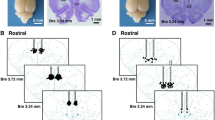Abstract
Electroacupuncture (EA) has been shown to modify the effects of various drugs of abuse, including alcohol. Inbred P rats were trained to drink alcohol voluntarily and then subjected to two periods of alcohol deprivation lasting 3 days. During the second deprivation, the rats received either EA or sham EA. The rats were pretreated with naltrexone (5 mg/kg) or saline 30 min before each of the EA or sham EA sessions. Approximately 6 h after the last naltrexone or saline treatment, the alcohol tubes were returned and alcohol and water intakes were recorded later at 2, 4, 6, and 24 h. Only EA led to a decrease in alcohol intake, which was most prominent at 6 and 24 h, and this inhibitory effect of EA was blocked by naltrexone, suggesting that activation of the endogenous opiate system may be responsible for EA’s effects on alcohol intake in the alcohol-dependent iP rats.






Similar content being viewed by others
References
Hughes J, Smith TW, Kosterlitz HW et al (1975) Identification of two related pentapeptides from the brain with potent opiate agonist activity. Nature 258:577–580
Mayer DJ, Price DD, Rafii A (1977) Antagonism of acupuncture analgesia in man by the narcotic antagonist naloxone. Brain Res 121:368–372
Han JS, Terenius L (1982) Neurochemical basis of acupuncture analgesia. Annu Rev Pharmacol Toxicol 22:193–220
Herz A (ed) (1993) Handbook of experimental pharmacology, vol 104/I. Springer-Verlag, Berlin
Han JS, Wang Q (1992) Mobilization of specific neuropeptides by peripheral stimulation of different frequencies. News Physiol Sci 7:176–180
Chen JH, Liang J, Wang GB et al (2005) Repeated 2 Hz peripheral electrical stimulations suppress morphine-induced CPP and improve spatial memory ability in rats. Exp Neurol 194:550–556
Kim JH, Chung JY, Kwon YK et al (2005) Acupuncture reduces alcohol withdrawal syndrome and c-Fos expression in rat brain. Am J Chin Med 33:887–896
Yoon SS, Kwon YK, Kim MR et al (2004) Acupuncture-mediated inhibition of ethanol-induced dopamine release in the rat nucleus accumbens through the GABAB receptor. Neurosci Lett 369:234–238
Zhao RJ, Yoon SS, Lee BH et al (2006) Acupuncture normalizes the release of accumbal dopamine during the withdrawal period and after the ethanol challenge in chronic ethanol-treated rats. Neurosci Lett 395:28–32
Yoshimoto K, Kato B, Sakai K et al (2001) Electroacupuncture stimulation suppresses the increase in alcohol-drinking behavior in restricted rats. Alcohol Clin Exp Res 25:63S–68S
Yoshimoto K, Fukuda F, Hori M et al (2006) Acupuncture stimulates the release of serotonin, but not dopamine, in the rat nucleus accumbens. Tohoku J Exp Med 208:321–326
Cabyoglu MT, Ergene N, Tan U (2006) The mechanism of acupuncture and clinical applications. Int J Neurosci 116:115–125
Han JS (2004) Acupuncture and endorphins. Neurosci Lett 361:258–261
Ulett GA, Han S, Han JS (1998) Electroacupuncture: mechanisms and clinical application. Biol Psychiatry 44:129–138
Kampov-Polevoy AB, Matthews DB, Gause L et al (2000) P rats develop physical dependence on alcohol via voluntary drinking: changes in seizure thresholds, anxiety, and patterns of alcohol drinking. Alcohol Clin Exp Res 24:278–284
Overstreet DH, McArthur RA, Rezvani AH et al (1997) Selective inhibition of alcohol intake in diverse alcohol-preferring rat strains by the 5-HT2A antagonists amperozide and FG 5974. Alcohol Clin Exp Res 21:1448–1454
Overstreet DH, Kampov-Polevoy AB, Rezvani AH et al (1999) Suppression of alcohol intake by chronic naloxone treatment in P rats: tolerance development and elevation of opiate receptor binding. Alcohol Clin Exp Res 23:1761–1771
Rezvani AH, Overstreet DH, Lee YW (1995) Attenuation of alcohol intake by ibogaine in three strains of alcohol-preferring rats. Pharmacol Biochem Behav 52:615–620
Funk CK, Zorrilla EP, Lee MJ et al (2007) Corticotropin-releasing factor 1 antagonists selectively reduce ethanol self-administration in ethanol-dependent rats. Biol Psychiatry 61:78–86
Walker BM, Koob GF (2007) The gamma-aminobutyric acid-B receptor agonist baclofen attenuates responding for ethanol in ethanol-dependent rats. Alcohol Clin Exp Res 31:11–18
Ren YH, Wang B, Luo F et al (2002) Peripheral electric stimulation attenuates the expression of cocaine-induced place preference in rats. Brain Res 957:129–135
Jordan JB (2006) Acupuncture treatment for opiate addiction: a systematic review. J Subst Abuse Treat 30:309–314
Kim YH, Schiff E, Waalen J et al (2005) Efficacy of acupuncture for treating cocaine addiction: a review paper. J Addict Dis 24:115–132
Acknowledgements
This study was funded jointly by NCCAM and NIAAA (P01-AT002038) through a Center of Excellence Program on “Alternative Therapies for Alcohol and Drug Abuse.” Additional Supports provided by NIDA Grant KO5 DA00343 (SEL), and by the National Basic Research Programme (2003-CB515407) of China.
Author information
Authors and Affiliations
Corresponding author
Additional information
Special issue article in honor of Ji-Sheng Han.
Rights and permissions
About this article
Cite this article
Overstreet, D.H., Cui, CL., Ma, YY. et al. Electroacupuncture Reduces Voluntary Alcohol Intake in Alcohol-preferring Rats via an Opiate-sensitive Mechanism. Neurochem Res 33, 2166–2170 (2008). https://doi.org/10.1007/s11064-008-9791-9
Received:
Accepted:
Published:
Issue Date:
DOI: https://doi.org/10.1007/s11064-008-9791-9




